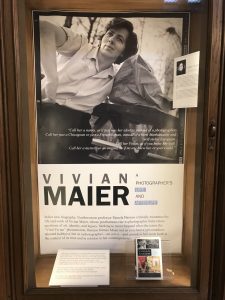In late 2008, an elderly woman slipped on the ice and hit her head near Sheridan and Juneway Terrace, on the southern border of Evanston. She died the following April.
Before her death, Vivian Maier had taken over 150,000 photographs of the people and places that had formed her everyday experience. Many of them had never been printed or even developed, they only became known after they were unknowingly purchased at an auction and exposed to the internet. In a very short period of time, Vivian Maier became simultaneously a household name and an unapproachable enigma, a stereotyped amateur eccentric who, it turned out, was truly talented.
In h e
e r new biography, Vivian Maier: A Photographer’s Life and Afterlife, Art Theory & Practice professor Pamela Bannos reframes Maier not as a North Shore nanny who took pictures in her spare time, but as a working photographer who supported herself as a domestic. Her carefully researched account dispels the idea that Maier’s success is the result of her posthumous discovery and promotion, and critiques the industry that has grown up around—and grown rich through—capitalizing on what she chose to leave behind. The picture of Maier that emerges in the text echoes the printing process itself: the hidden image growing clearer with the passage of time, until the vision of the artist is revealed.
r new biography, Vivian Maier: A Photographer’s Life and Afterlife, Art Theory & Practice professor Pamela Bannos reframes Maier not as a North Shore nanny who took pictures in her spare time, but as a working photographer who supported herself as a domestic. Her carefully researched account dispels the idea that Maier’s success is the result of her posthumous discovery and promotion, and critiques the industry that has grown up around—and grown rich through—capitalizing on what she chose to leave behind. The picture of Maier that emerges in the text echoes the printing process itself: the hidden image growing clearer with the passage of time, until the vision of the artist is revealed.
Pamela Bannos is the featured faculty member for November and December. Examples of her work are on display on the new books table in the Martin Reading Room, and as part of the Vivian Maier presentation in the lobby display case.
